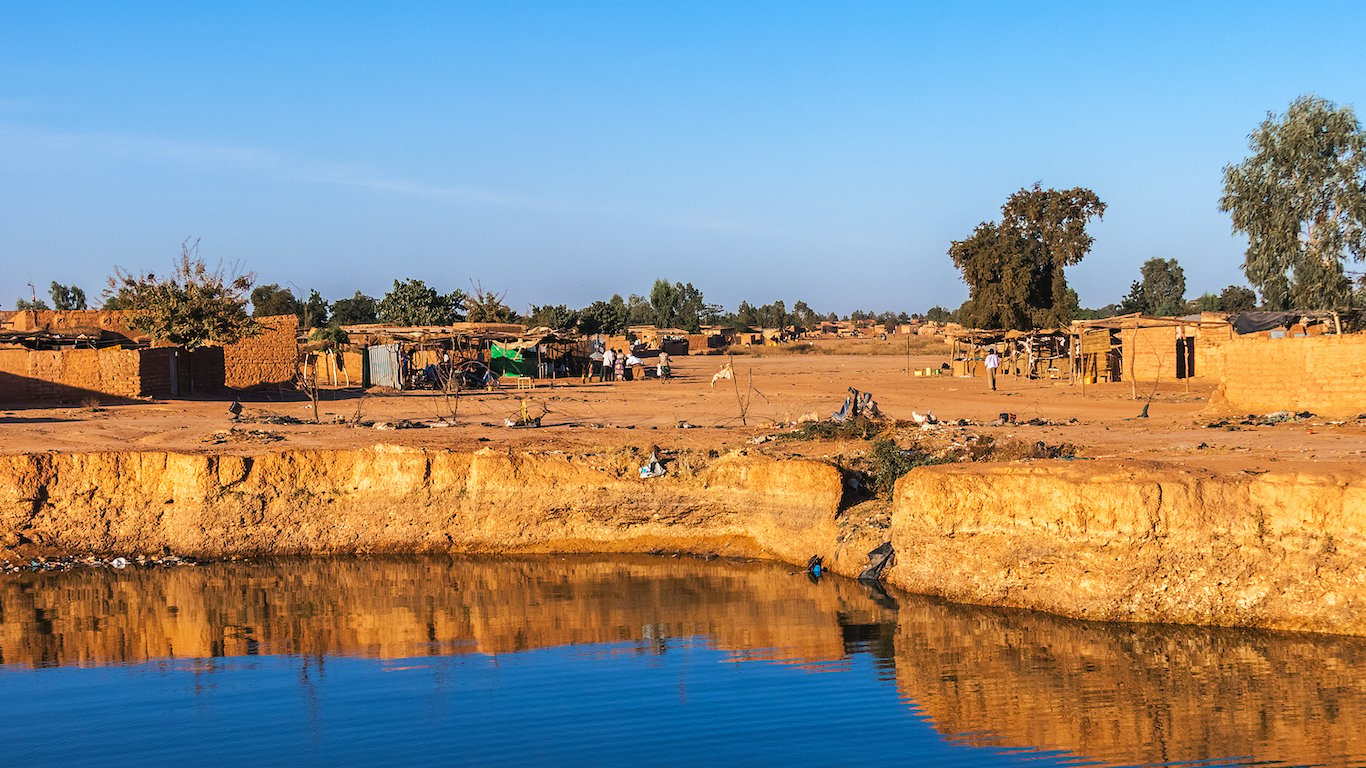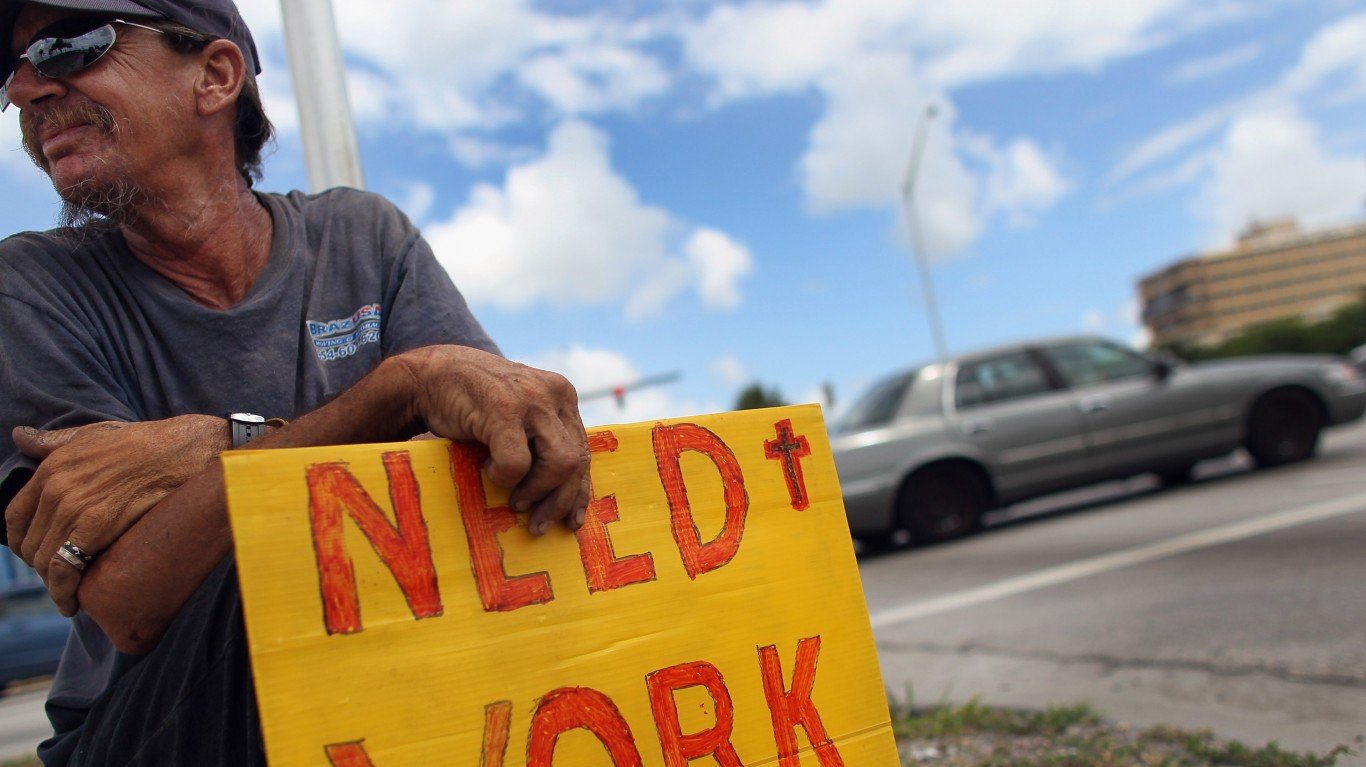

Economic output in the United States fell for the first time in over a decade in the first quarter of 2020. The following quarter, GDP declined by 9.5% — by far the largest contraction in over 70 years. Though the U.S. economy rebounded in the third quarter of 2020, GDP is still well below what it was a year and a half ago — and in some states, the economic fallout of the COVID-19 pandemic has been far worse.
Using GDP data from the Bureau of Economic Analysis, 24/7 Wall St. determined how each state economy was affected by the COVID-19 pandemic. States are ranked by percent change in GDP from Q3 2019 to Q3 2020. Over that period, the U.S. economy contracted by 2.8% and only three states reported economic growth.
The states that reported the worst economic collapses over the past year tend to be those that rely heavily on industries that were hit especially hard by the COVID-19 pandemic. These industries include oil and gas extraction — which was slammed by falling commodity prices in the face of reduced demand during the pandemic — as well as the accommodation and food services sector and arts entertainment and recreation sector, which suffered considerably as nonessential travel effectively ground to a halt for much of 2020. These are the 50 most popular restaurants that have closed permanently due to the pandemic.
In most states, the economic downturn was accompanied by steep job losses. Most states have shed tens of thousands of jobs over the past year, and the unemployment rate in every state is several points higher now than it was at the same time last year. Here is a look at the cities with the worst COVID-19 unemployment crisis right now.
Click here to see the state economies hit hardest by COVID-19.

1. Utah
> 1-year GDP change: +1.1%
> Fastest growing industry: Construction (+10.6%)
> Fastest shrinking industry: Arts, entertainment, and recreation (-45.5%)
> Nov. 2020 unemployment rate: 4.3%
Because of the COVID-19 pandemic and efforts to contain the spread of the virus, the U.S. economy contracted by 2.8% from the third quarter of 2019 to the third quarter of 2020. Over that period, Utah was one of only three states to report economic growth. Due in large part to a surge in construction, Utah’s economy expanded by a nation-leading 1.1% over the past year.
Though Utah’s economy stands alone as especially resilient in these unprecedented times, it too has suffered considerably due to the pandemic. The state’s arts, entertainment, and recreation industry shrank by nearly half, and its November unemployment rate stood at 4.3%, well above the comparable 2.4% jobless rate one year ago.
[in-text-ad]

2. Washington
> 1-year GDP change: +0.5%
> Fastest growing industry: Agriculture, forestry, fishing and hunting (+15.5%)
> Fastest shrinking industry: Arts, entertainment, and recreation (-55.1%)
> Nov. 2020 unemployment rate: 6.0%
Washington’s economic growth of 0.5% from the third quarter of 2019 to the third quarter in 2020 was a fraction of the state’s 3.7% growth over the same period one year earlier.
The relatively stagnant growth was due in large part to the COVID-19 pandemic, which took a considerable toll on a number of industries in the state. Washington’s accommodation and food services industry contracted by 18.6%, while economic activity in the resource extraction sector fell by 22.7%. As was the case in most states, Washington’s hardest hit industry was arts, entertainment, and recreation, which reported a 55.1% economic decline in the last year.

3. Idaho
> 1-year GDP change: +0.1%
> Fastest growing industry: Utilities (+12.5%)
> Fastest shrinking industry: Arts, entertainment, and recreation (-41.1%)
> Nov. 2020 unemployment rate: 4.8%
Idaho is one of only three states with an economy that grew between Q3 2019 and Q3 2020. Despite the nationwide economic slowdown resulting from the COVID-19 pandemic, Idaho reported relatively strong growth in its utilities, construction, finance, and wholesale trade sectors. Though several industries in the state contracted, in many of them, the contraction was not as pronounced as it was in other parts of the country. These industries include health care, education, and accommodation and food services.
Despite the modest economic growth in the past year, Idaho’s job market is in far worse shape than it was one year ago. As of November 2020, 4.8% of the labor force was unemployed, compared to 2.9% in November 2019.
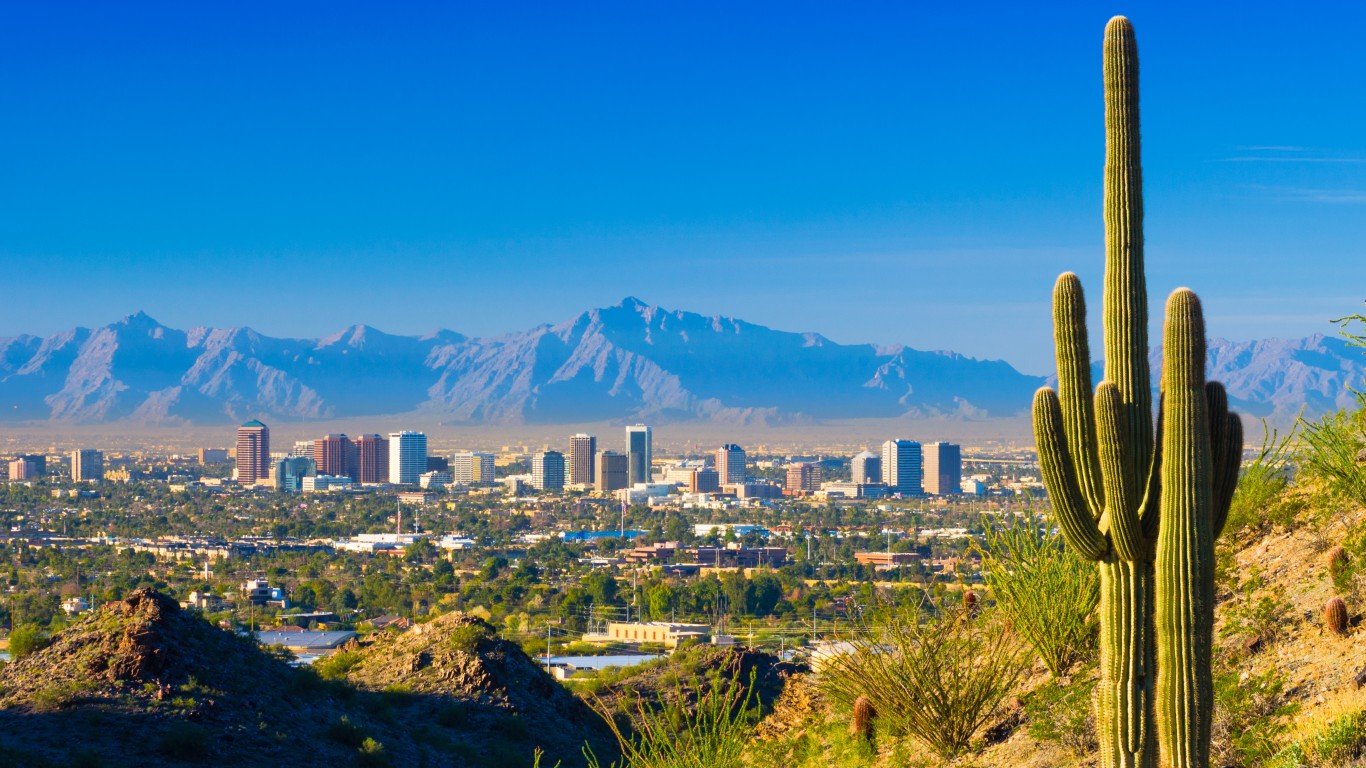
4. Arizona
> 1-year GDP change: -0.1%
> Fastest growing industry: Management of companies and enterprises (+13.2%)
> Fastest shrinking industry: Arts, entertainment, and recreation (-45.1%)
> Nov. 2020 unemployment rate: 7.8%
Of the 47 states to report an economic downturn between Q3 2019 and Q3 2020, Arizona’s was the least pronounced. Arizona’s economic output totaled $324.7 billion in the third quarter of 2020, down 0.1% from $325.1 billion the year before. For context, the entire U.S. economy reported a 2.8% contraction over the same period. Economic damage resulting from the COVID-19 pandemic was mitigated in Arizona by stronger than average growth in the manufacturing, wholesale trade, and retail industries.
While economic activity remained relatively flat in Arizona over the past year, the state’s job market has taken a much larger hit. Arizona’s November unemployment rate was 7.8%, compared to 4.5% the year before.
[in-text-ad-2]

5. Colorado
> 1-year GDP change: -1.4%
> Fastest growing industry: Information (+10.7%)
> Fastest shrinking industry: Arts, entertainment, and recreation (-40.0%)
> Nov. 2020 unemployment rate: 6.4%
Colorado’s economy contracted by 1.4% between Q3 2019 and Q3 2020. Over the 12 months going into that period, Colorado reported 4.6% economic growth. The economic decline in the state was largely the result of the COVID-19 pandemic, which contributed to double-digit declines in the state’s agriculture, transportation and warehousing, accommodation and food services, and arts, entertainment, and recreation industries.
Despite the decline, Colorado’s economy was not affected nearly as bad as that of most other states. Blue-collar and service workers were far more likely to be affected by the pandemic than white-collar workers, and in Colorado, 42.7% of adults have a bachelor’s degree or higher, compared to 33.1% of adults nationwide.

6. Iowa
> 1-year GDP change: -1.4%
> Fastest growing industry: Agriculture, forestry, fishing and hunting (+12.5%)
> Fastest shrinking industry: Arts, entertainment, and recreation (-31.7%)
> Nov. 2020 unemployment rate: 3.6%
Over the past year, Iowa’s economy contracted by 1.4%. The economic fallout, largely attributable to the COVID-19 pandemic, was not as pronounced in Iowa as it was in much of the rest of the country, however, as the U.S. economy contracted by 2.8% over the same period. Similarly, job losses have not been as widespread in Iowa as they have across the U.S. as a whole. Unemployment in Iowa in November 2020 hit 3.6% — up slightly from 2.8% the same month last year. Meanwhile, the national unemployment rate as of November 2020 was 6.7%, compared to 3.5% in November 2019.
[in-text-ad]
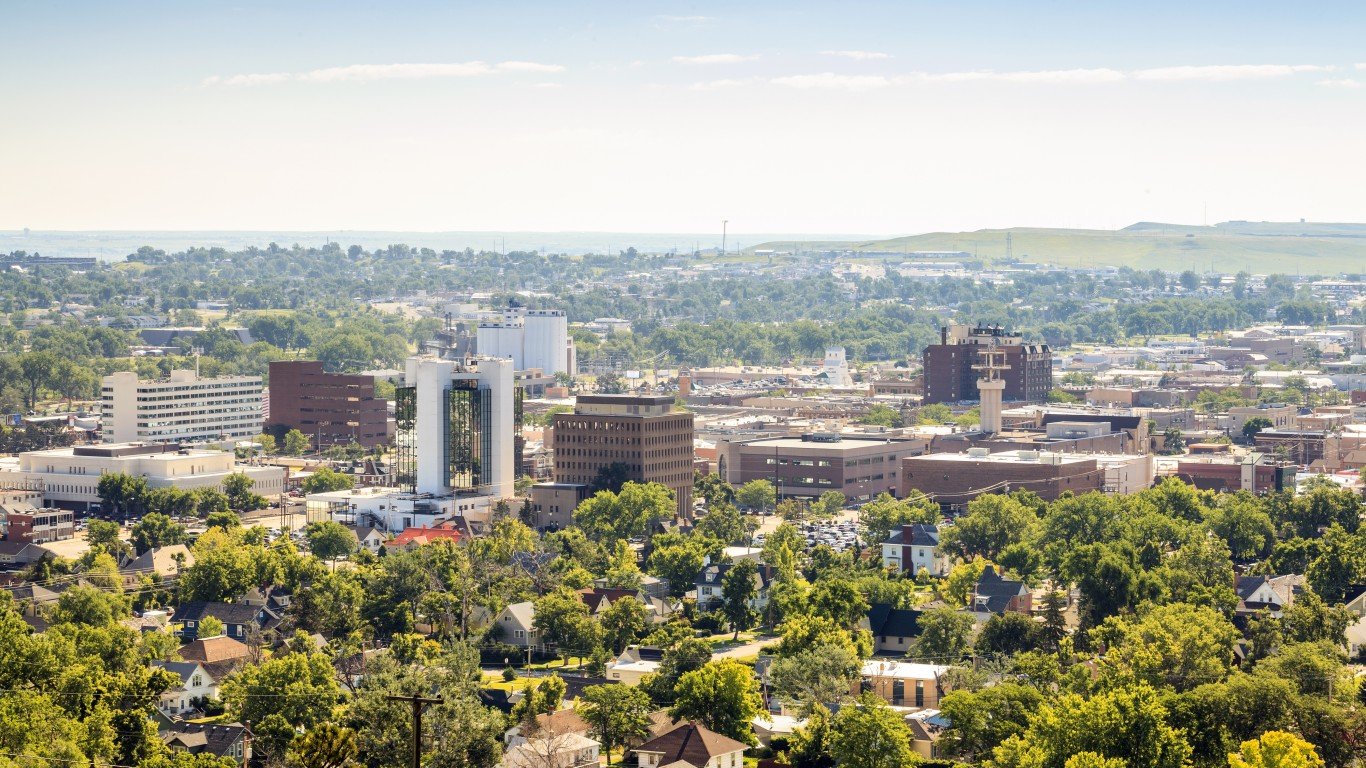
7. South Dakota
> 1-year GDP change: -1.5%
> Fastest growing industry: Agriculture, forestry, fishing and hunting (+11.4%)
> Fastest shrinking industry: Arts, entertainment, and recreation (-22.0%)
> Nov. 2020 unemployment rate: 3.5%
South Dakota’s GDP in Q3 of 2020 totaled $47.1 billion — down 1.5% from the third quarter of 2019. The state’s economic decline was far less severe than in much of the rest of the country. Nationwide, economic output fell by 2.8% over the same period. The relatively limited economic damage in South Dakota is likely due in part to the state’s response to the COVID-19 pandemic. Policy makers in the state appeared to prioritize the economy over public health, as South Dakota was one of only a handful of states to not issue a statewide stay-at-home order in the early days of the pandemic.

8. Georgia
> 1-year GDP change: -1.7%
> Fastest growing industry: Utilities (+8.1%)
> Fastest shrinking industry: Arts, entertainment, and recreation (-28.0%)
> Nov. 2020 unemployment rate: 5.7%
Georgia’s economic output fell by 1.7% from Q3 2019 to Q3 2020. The industries that reported the largest economic contraction tended to be those that were highly exposed to measures implemented to contain the spread of COVID-19. These include accommodation and food services, transportation and warehousing, and arts, entertainment, and recreation — each of which reported a double-digit decline in economic output.
Georgia’s falling GDP is reflected in the worsening condition of the state’s job market. Over the same period of economic downturn, the number of people working in the state fell by 331,700.

9. North Carolina
> 1-year GDP change: -1.7%
> Fastest growing industry: Finance and insurance (+6.3%)
> Fastest shrinking industry: Arts, entertainment, and recreation (-41.6%)
> Nov. 2020 unemployment rate: 6.2%
North Carolina’s economy contracted by 1.7% in the past year. The contraction was driven by steep output declines in a number of industries, including accommodation and food services and arts, entertainment, and recreation — two sectors hit hard by efforts to contain the spread of COVID-19.
While North Carolina’s GDP decline was not as severe as it was in most other states, job losses were worse than average. Between November of 2019 and November of 2020, the number of people working in North Carolina fell by 7.5%, a larger decline than in all but a dozen other states.
[in-text-ad-2]

10. Arkansas
> 1-year GDP change: -1.8%
> Fastest growing industry: Utilities (+13.0%)
> Fastest shrinking industry: Accommodation and food services (-17.3%)
> Nov. 2020 unemployment rate: 6.2%
Economic output in Arkansas was 1.8% lower in Q3 of 2020 than the same quarter in 2019. The decline was largely due to the COVID-19 pandemic and the resulting national economic collapse. Over the same 12-month period the previous year, Arkansas’s economy grew by 0.8%.
As is the case nationwide, unemployment climbed in Arkansas as economic output fell. The most recent jobless rate in the state, which was November 2020, stands at 6.2%, up from 3.5% one year earlier.

11. Alabama
> 1-year GDP change: -1.8%
> Fastest growing industry: Utilities (+6.7%)
> Fastest shrinking industry: Arts, entertainment, and recreation (-36.4%)
> Nov. 2020 unemployment rate: 4.4%
Economic output totaled $197.7 billion in Alabama in Q3 2020, down 1.8% from $201.4 billion one year earlier. Despite the annual decline, Alabama’s economy has improved from its COVID-19 trough. In Q2 of 2020, Alabama’s GDP was only $183.6 billion — a low not previously seen in the state in over half a decade.
While economic output fell in most industries in Alabama in the past year, some still managed to grow. The state’s utilities, finance, and manufacturing sectors all generated more output in Q3 2020 than they did the previous year.
[in-text-ad]
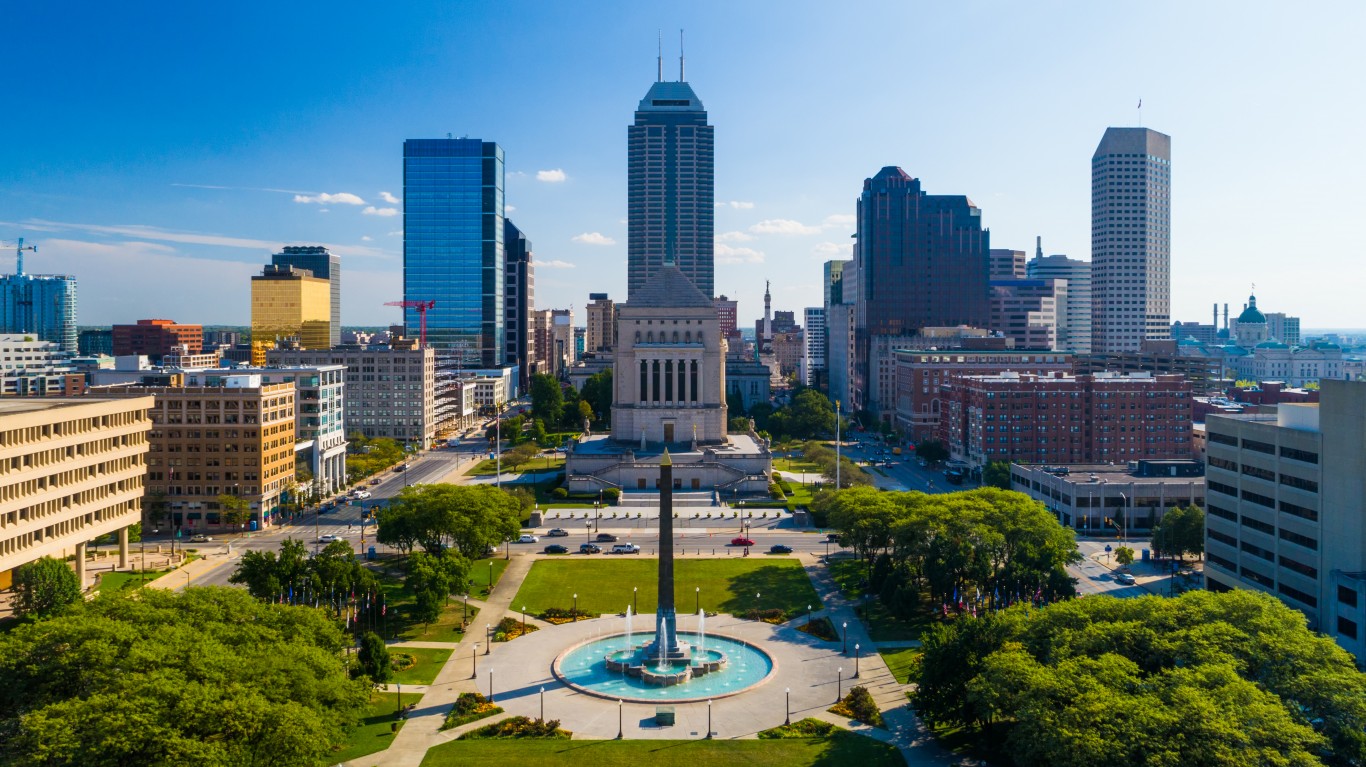
12. Indiana
> 1-year GDP change: -1.9%
> Fastest growing industry: Agriculture, forestry, fishing and hunting (+28.4%)
> Fastest shrinking industry: Arts, entertainment, and recreation (-27.6%)
> Nov. 2020 unemployment rate: 5.0%
Due to the COVID-19 pandemic, few industries have expanded in the United States over the past year. One that defied the broader economic collapse, however, was agriculture, forestry, fishing and hunting. In Indiana, that industry expanded by 28.4%, more than in any other state other than Illinois and well above the comparable 6.7% national industry growth.
Still, Indiana’s economy contracted by 1.9% over the last 12 months. Expansion in industries like agriculture was offset by steep declines in others that were harmed far more by the pandemic, including arts, entertainment, and recreation and oil and gas extraction.

13. Mississippi
> 1-year GDP change: -1.9%
> Fastest growing industry: Utilities (+18.4%)
> Fastest shrinking industry: Arts, entertainment, and recreation (-32.9%)
> Nov. 2020 unemployment rate: 6.4%
Mississippi’s economy contracted by 1.9% between Q3 2019 and Q3 2020, a smaller contraction than most states reported over the same period. The state’s economic fallout during the COVID-19 pandemic was mitigated by strong growth in its utilities sector, which expanded by 18.4% over the same period — stronger growth than in any other state.
Unlike most other sectors, utilities were not especially exposed to a slowdown during the pandemic. Nationwide, the utilities industry reported a 5.2% growth in the past year.

14. Oregon
> 1-year GDP change: -1.9%
> Fastest growing industry: Agriculture, forestry, fishing and hunting (+11.0%)
> Fastest shrinking industry: Arts, entertainment, and recreation (-49.9%)
> Nov. 2020 unemployment rate: 6.0%
Oregon is one of only 16 states to not report a GDP decline of 2% or more from Q3 2019 to Q3 2020. The state’s smaller than average economic contraction was due in part to the relative resilience of manufacturing, one of its largest sectors. Over the past year, the manufacturing sector in Oregon contracted by just 0.3%, one-third of the industry’s overall decline nationwide.
Though the COVID-19 pandemic’s impact on Oregon’s GDP was relatively small, its impact on employment in the state was anything but. There were nearly 158,000 fewer people working in Oregon in November 2020 than at the same time in 2019. The 7.8% decline in employment is the 11th largest of any state.
[in-text-ad-2]

15. Maryland
> 1-year GDP change: -1.9%
> Fastest growing industry: Agriculture, forestry, fishing and hunting (+14.6%)
> Fastest shrinking industry: Arts, entertainment, and recreation (-45.5%)
> Nov. 2020 unemployment rate: 6.8%
Over the past year, the government sector, Maryland’s largest by GDP, expanded by 1.2%, even as the government sector shrank by 2.1% nationwide. Partially as a result, Maryland’s economy contracted by just 1.9% between Q3 2019 and Q3 2020, a smaller economic decline than most states reported over that period.
Still, industries like accommodation and food services as well as arts, entertainment, and recreation reported staggering declines. They also likely account for much of the state’s current jobless crisis. Maryland’s November 2020 unemployment was at 6.8%, double the 3.4% jobless rate one year earlier.

16. Kansas
> 1-year GDP change: -1.9%
> Fastest growing industry: Agriculture, forestry, fishing and hunting (+11.1%)
> Fastest shrinking industry: Arts, entertainment, and recreation (-33.6%)
> Nov. 2020 unemployment rate: 5.6%
The Kansas economy generated $157.1 billion in Q3 2020, down 1.9% from one year prior. Despite the decline, the state’s economy has recovered substantially from Q2, when GDP totaled just $145.9, a low not previously seen in at least the last half decade.
The sectors that contracted the most in the state in the past year were also those that were most exposed to fallout from the COVID-19 pandemic. These include arts, entertainment, and recreation, accommodation and food services, transportation and warehousing, and oil and gas extraction.
[in-text-ad]

17. Florida
> 1-year GDP change: -2.0%
> Fastest growing industry: Utilities (+9.2%)
> Fastest shrinking industry: Arts, entertainment, and recreation (-26.5%)
> Nov. 2020 unemployment rate: 6.4%
Due in large part to steep declines in sectors related to tourism — such as arts, entertainment, and recreation as well as food and accommodation services — Florida’s GDP contracted by 2.0% from Q3 2019 to Q3 2020.
So far during the COVID-19 pandemic, Florida’s economy bottomed out in Q2, when its GDP was just $880.4 billion — 7.4% lower than it is now. Whether the economy continued to grow in the final quarter of 2020 remains to be seen.

18. Nebraska
> 1-year GDP change: -2.0%
> Fastest growing industry: Mining, quarrying, and oil and gas extraction (+8.7%)
> Fastest shrinking industry: Arts, entertainment, and recreation (-36.9%)
> Nov. 2020 unemployment rate: 3.1%
Nebraska is one of only 19 states where GDP did not contract by more than 2.0% from Q3 2019 to Q3 2020. The relatively small decline was due to stronger than average growth in the state’s finance and insurance sector — which is also the state’s largest by total output. Nebraska’s finance and insurance industry expanded by 6.8% in the last year, faster than the industry’s growth across the U.S. as a whole of 4.3%.
Nebraska’s job market is also stronger than nearly every other state. Just 3.1% of the labor force was unemployed in November 2020, tied for the lowest jobless rate in the country. Nationwide, the comparable monthly unemployment rate stands at 6.7%.

19. Virginia
> 1-year GDP change: -2.0%
> Fastest growing industry: Utilities (+6.6%)
> Fastest shrinking industry: Arts, entertainment, and recreation (-45.1%)
> Nov. 2020 unemployment rate: 4.9%
Virginia’s economy contracted by 2.0% over the last year, less than the comparable 2.8% national economic decline. Though Virginia’s GDP in Q3 of 2020, at $481.4 billion, is at its lowest level compared to Q3 2019, it is a marked improvement from the previous quarter. Virginia’s economy expanded by 6.7% between Q2 2020 and Q3 2020.
Over the last year, the industries reporting the largest decline in economic output in Virginia were accommodation and food services, transportation and warehousing, and arts, entertainment, and recreation.
[in-text-ad-2]
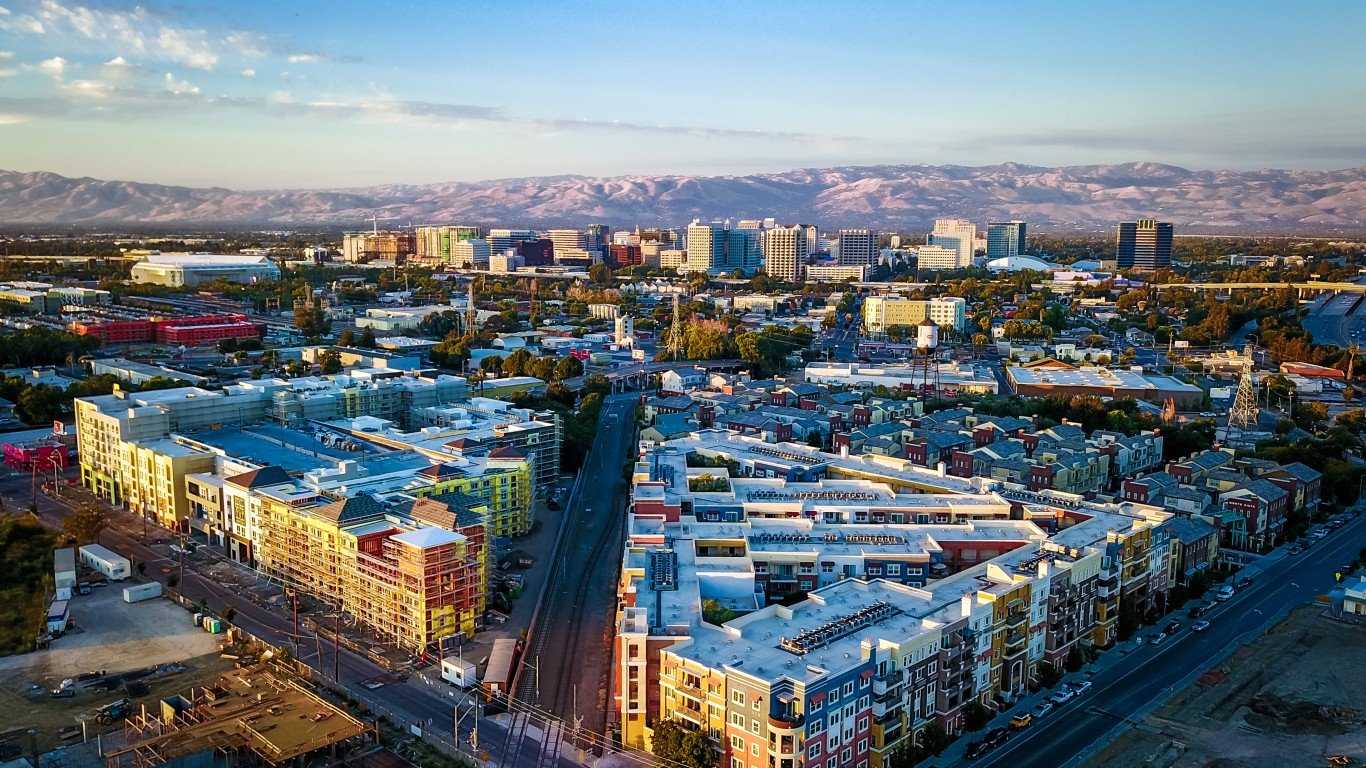
20. California
> 1-year GDP change: -2.1%
> Fastest growing industry: Agriculture, forestry, fishing and hunting (+14.5%)
> Fastest shrinking industry: Arts, entertainment, and recreation (-49.8%)
> Nov. 2020 unemployment rate: 8.2%
California, which has by far the largest economy in the United States, has not sustained as much of an economic downturn as much of the rest of the country during the COVID-19 pandemic. California’s economic output fell by just 2.1% from Q3 2019 to Q3 2020. Meanwhile, the U.S. economy contracted by 2.8% over the same period.
As is the case in most states, the arts, entertainment, and recreation sectors contracted the most in California over the past year, with economic output cut roughly in half. Meanwhile, information, one of California’s largest industries, expanded by 5.3%.

21. Kentucky
> 1-year GDP change: -2.6%
> Fastest growing industry: Utilities (+10.1%)
> Fastest shrinking industry: Mining, quarrying, and oil and gas extraction (-24.4%)
> Nov. 2020 unemployment rate: 5.6%
Over the last year, Kentucky’s economy contracted by 2.6%, in line with the 2.8% national economic decline over the same time. Unlike much of the rest of the country, however, mining, quarrying, and oil and gas extraction reported the largest decline in output over the past year in Kentucky, while nationwide the hardest hit industry has been arts, entertainment, and recreation.
The mining and resource extraction industry’s decline in Kentucky was due in large part to declines in global commodity prices precipitated by the COVID-19 pandemic. The price of coal was down about 50% in 2020 from early 2019, and Kentucky is the fifth largest coal-producing state in the country.
[in-text-ad]

22. Delaware
> 1-year GDP change: -2.7%
> Fastest growing industry: Utilities (+7.0%)
> Fastest shrinking industry: Arts, entertainment, and recreation (-36.8%)
> Nov. 2020 unemployment rate: 5.1%
Delaware’s economy generated $62.5 billion in Q3 of 2020, 2.7% less than it did in the same quarter the previous year. The finance insurance sector, the largest in the state by total output, expanded by just 1.2% over the past year, below the 4.3% national industry expansion over the same period. The industry that reported the largest year-over-year decline in economic output in Delaware was arts, entertainment, and recreation. The industry shrank by 36.8% over the past year, which was actually smaller than the industry’s contraction nationwide of 45.3%.

23. Missouri
> 1-year GDP change: -2.7%
> Fastest growing industry: Utilities (+7.9%)
> Fastest shrinking industry: Arts, entertainment, and recreation (-30.2%)
> Nov. 2020 unemployment rate: 4.4%
Over the past year, Missouri’s economy contracted by 2.7%, in line with the national economic contraction of 2.8%. The decline in Missouri was driven by a 3.3% reduction in economic output in the manufacturing sector — the largest in the state. Nationwide, manufacturing contracted by 0.9%. Missouri’s arts, entertainment, and recreation industry reported the largest decline, at 30.2%.
Contractions in these industries were partially offset by growth in utilities, finance and insurance, and management sectors.

24. Minnesota
> 1-year GDP change: -2.8%
> Fastest growing industry: Agriculture, forestry, fishing and hunting (+23.8%)
> Fastest shrinking industry: Arts, entertainment, and recreation (-38.0%)
> Nov. 2020 unemployment rate: 4.4%
Minnesota’s GDP declined 2.8% from Q3 2019 to Q3 2020, the same as the overall U.S. economic contraction over that same period. The state has one of the largest agriculture, forestry, fishing and hunting industries of any state, generating over $9.7 billion in Q3 2020 — a 23.8% increase compared to a year earlier.
Minnesota also reported relatively high growth in its utilities and its finance and insurance sectors, helping to mitigate some of the large declines in its information, management, and government sectors. The state has a relatively resilient job market, with monthly unemployment rates consistently that were consistently lower than the overall U.S. unemployment rates throughout the COVID-19 pandemic.
[in-text-ad-2]
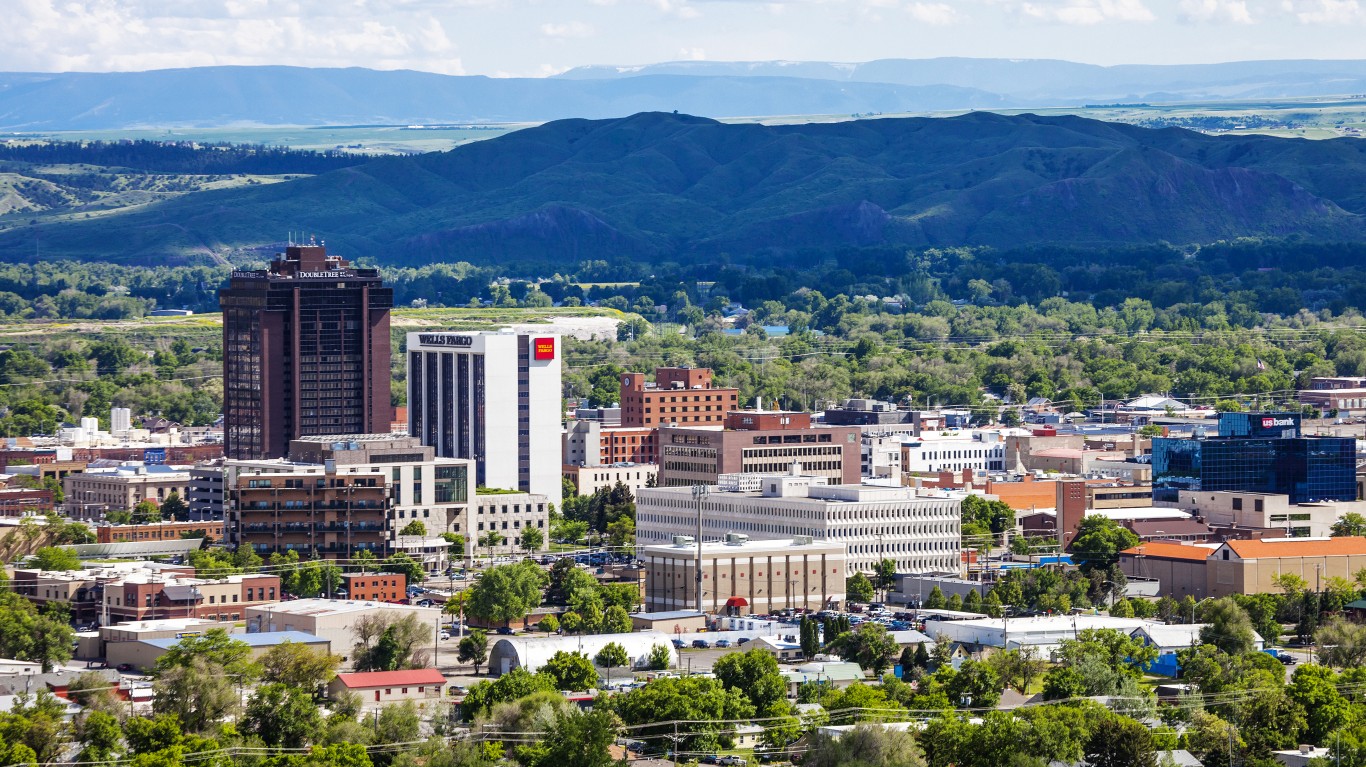
25. Montana
> 1-year GDP change: -2.8%
> Fastest growing industry: Utilities (+12.7%)
> Fastest shrinking industry: Arts, entertainment, and recreation (-27.2%)
> Nov. 2020 unemployment rate: 4.9%
Montana is one of two states with a one-year 2.8% GDP decline, in line with the overall U.S. decline. The state’s economic output fell from over $48.2 billion in the third quarter of 2019 to less than $46.9 billion in the third quarter of 2020.
Though construction GDP declined by 1.4% nationwide from Q3 2019 to Q3 2020, the sector actually grew by 3.6% in Montana during that time. The state’s utilities economic output grew by 12.7% during that time as well — more than double the 5.2% nationwide increase in the sector, and the fifth highest share of any state. All but three states lost jobs amid the pandemic. Montana’s employment declined by 2.1% from September 2019 to September 2020, one of the smallest declines among states.

26. Wisconsin
> 1-year GDP change: -2.9%
> Fastest growing industry: Agriculture, forestry, fishing and hunting (+19.5%)
> Fastest shrinking industry: Arts, entertainment, and recreation (-33.4%)
> Nov. 2020 unemployment rate: 5.0%
Wisconsin’s 1-year GDP decline of 2.9% is the 26th largest among states. Like nearly every other state, Wisconsin’s arts, entertainment, and recreation industry contracted more than all others. The sector’s economic output declined by over one-third in 2020’s Q3 compared to 2019’s Q3.
Though Wisconsin had a relatively large GDP decline, its total employment only declined by 0.8% from September 2019 to September 2020. Of the 47 states with employment declines during that time, Wisconsin’s was the second lowest.
[in-text-ad]

27. Rhode Island
> 1-year GDP change: -2.9%
> Fastest growing industry: Finance and insurance (+9.5%)
> Fastest shrinking industry: Arts, entertainment, and recreation (-44.0%)
> Nov. 2020 unemployment rate: 7.3%
Rhode Island’s Q3 2020 GDP of $51.8 billion was 2.9% smaller than its Q3 2019 GDP of $53.4 billion, even as the state’s finance and insurance sector grew nearly 10% to over $5 billion in economic output in Q3 2020.
The largest sector in Rhode Island is government and government enterprises. From Q3 2019 to Q3 2020, this sector’s economic output dropped by 3.2%, from nearly $7.3 billion to just over $7.0 billion. Nationwide, this sector declined by 2.1% during that same time period.

28. Illinois
> 1-year GDP change: -3.0%
> Fastest growing industry: Agriculture, forestry, fishing and hunting (+51.6%)
> Fastest shrinking industry: Arts, entertainment, and recreation (-48.2%)
> Nov. 2020 unemployment rate: 6.9%
Illinois had the nation’s fifth largest economy in Q3 of 2019, with a GDP of $774.9 billion. Though it still ranked fifth a year later, its GDP contracted by 3.0%, down to $751.4 billion.
While the state had a relatively large one-year GDP decline, its agriculture, forestry, fishing, and hunting industry was much larger in Q3 2020 than the year before. The sector’s economic output increased by over 50%, from $8.3 billion to $12.6 billion. No other state had even a 30% increase in its agricultural sector.

29. South Carolina
> 1-year GDP change: -3.1%
> Fastest growing industry: Finance and insurance (+6.5%)
> Fastest shrinking industry: Arts, entertainment, and recreation (-38.6%)
> Nov. 2020 unemployment rate: 4.4%
South Carolina’s GDP shrank by 3.1% from the third quarter of 2019 to the third quarter of 2020. Like nearly every other state, the state’s fastest shrinking industry was its arts, entertainment, and recreation sector, which went from over $1.4 billion economic output in Q3 2019 to less than $900 million in Q3 2020.
Though South Carolina’s GDP contracted significantly amid the pandemic, its unemployment rate stayed consistently lower than the national rate. The state’s February unemployment rate was one of the five lowest, at 2.5%. After peaking in May at 12.4%, it has since declined back to 4.4% as of November.
[in-text-ad-2]

30. Ohio
> 1-year GDP change: -3.2%
> Fastest growing industry: Agriculture, forestry, fishing and hunting (+7.6%)
> Fastest shrinking industry: Arts, entertainment, and recreation (-39.9%)
> Nov. 2020 unemployment rate: 5.7%
Ohio’s GDP in Q3 2020 was $597.3 billion, 3.2% lower than it was in Q3 2019. The COVID-19 pandemic has had a dramatic effect not only on economic output, but also on the job market of each state. Total employment declined by over 380,000 from September 2019 to September 2020, a 6.9% drop.
Though its overall GDP fell during that 12-month period, it was boosted somewhat by a 7.6% increase in the agriculture, forestry, fishing, and hunting sector, as well as a 1.3% increase in construction, even though the nationwide economic output of the construction sector fell 1.4% during that same time.

31. Connecticut
> 1-year GDP change: -3.3%
> Fastest growing industry: Information (+5.7%)
> Fastest shrinking industry: Arts, entertainment, and recreation (-44.9%)
> Nov. 2020 unemployment rate: 8.2%
Connecticut, like every other state in the New England region, had a greater one-year GDP decline than the national decline. The state’s Q3 2020 GDP was $242.8 billion, 3.3% lower than its Q3 2019 GDP of $251.0 billion. For context, the overall U.S. GDP fell by 2.8% during that same time period.
Like the U.S. as a whole, Connecticut’s GDP declined sharply from Q1 to Q2 2020 as schools and businesses began shutting down in March, but it recovered somewhat by Q3. Yet the state’s job market has struggled to keep pace with the nation’s economic improvement towards the end of 2020. Connecticut’s unemployment rate increased from 6.1% in October to 8.2% in November, even as the U.S. unemployment rate decreased from 6.9% to 6.7%.
[in-text-ad]

32. Massachusetts
> 1-year GDP change: -3.3%
> Fastest growing industry: Agriculture, forestry, fishing and hunting (+15.2%)
> Fastest shrinking industry: Arts, entertainment, and recreation (-54.9%)
> Nov. 2020 unemployment rate: 6.7%
Massachusetts had among the earliest and strictest COVID-19 travel and social distancing restrictions in the country. With tourism ground nearly to a halt, the economic output of arts, entertainment, and recreation was more than cut in half — declining from over $6.1 billion in Q3 2019 to less than $2.8 billion in Q3 2020. It was just one of the numerous Massachusetts sectors that saw a decline in GDP over the past year, leading to an overall 3.3% GDP drop.
Along with the drop in GDP, Massachusetts had one of the largest declines in total employment over that time. There were more than 327,000 fewer people working in the state in Q3 2020 than in Q3 2019, an 8.8% decline — the seventh sharpest drop among all states.

33. Maine
> 1-year GDP change: -3.4%
> Fastest growing industry: Utilities (+14.8%)
> Fastest shrinking industry: Arts, entertainment, and recreation (-47.5%)
> Nov. 2020 unemployment rate: 5.0%
State economies in the Northeast were hit especially hard by the pandemic in the past year, and Maine was not spared. Maine’s economic output contracted by 3.4% over the past year, with the state’s arts, entertainment, and recreation industry shrinking by nearly 50%. Maine’s total economic output in Q3 of 2020 totaled just $57.0 billion, the lowest level since 2017.
Job losses have accompanied economic decline in Maine. Overall employment declined by 4.6%, or about 31,000 jobs, from September 2019 to September 2020.

34. North Dakota
> 1-year GDP change: -3.4%
> Fastest growing industry: Agriculture, forestry, fishing and hunting (+18.8%)
> Fastest shrinking industry: Arts, entertainment, and recreation (-22.8%)
> Nov. 2020 unemployment rate: 4.5%
North Dakota is one of the largest oil-producing states in the country, with its mining, quarrying, and oil and gas extraction sector accounting for $8.5 billion-worth of economic output in the third quarter of 2019, or over 15% of the state’s $53.9 billion GDP for that quarter. In the third quarter of 2020, the output of this sector fell by more than 21% to $6.7 billion.
This $1.9 billion decline in the mining, quarrying, and oil and gas extraction sector actually exceeded North Dakota’s overall GDP contraction. The state’s overall economic output shrank by $1.8 billion — from $53.9 billion in Q3 2019 to $52.1 billion in Q3 2020. The extraction sector’s losses were offset by growth in sectors like agriculture, management, educational services, and government.
[in-text-ad-2]

35. Texas
> 1-year GDP change: -3.4%
> Fastest growing industry: Finance and insurance (+4.5%)
> Fastest shrinking industry: Arts, entertainment, and recreation (-44.9%)
> Nov. 2020 unemployment rate: 8.1%
Oil and gas extraction is one of the largest industries in Texas — and it took a substantial hit during the COVID-19 pandemic. Due in large part to reduced demand for oil and gas, Texas’s oil and gas extraction industry shrank by 18.7% in the past year. The reduced output in one of the state’s economic pillars contributed to a statewide 3.4% economic contraction over the same period.
The economic decline has sent unemployment soaring in the Lone Star state. Texas’ 8.1% jobless rate for November 2020 is among the highest of any state and more than double the 3.5% rate of one year prior.

36. New Jersey
> 1-year GDP change: -3.5%
> Fastest growing industry: Information (+7.7%)
> Fastest shrinking industry: Arts, entertainment, and recreation (-50.9%)
> Nov. 2020 unemployment rate: 10.2%
New Jersey’s economy generated just $538.5 billion in Q3 2020, down 3.5% from $558.1 billion one year earlier. The state’s arts, entertainment, and recreation reported a 50.9% decline in economic output over the same period due in no small part to the temporary shutdown of Atlantic City — the southern New Jersey city with a gaming industry that makes it a popular tourist destination. New Jersey’s unemployment rate for November 2020 stood at 10.2%, higher than in any other state and more than double the state’s 3.7% jobless rate one year earlier.
[in-text-ad]

37. New Hampshire
> 1-year GDP change: -3.6%
> Fastest growing industry: Finance and insurance (+10.3%)
> Fastest shrinking industry: Arts, entertainment, and recreation (-61.9%)
> Nov. 2020 unemployment rate: 3.8%
In nearly every state, the arts, entertainment, and recreation industry shrank faster than all other industries amid the COVID-19 pandemic, but in no state has the sector declined as much as in New Hampshire. In Q3 2019, the arts, entertainment, and recreation sector accounted for nearly $1.2 billion of the state’s overall GDP of $77.2 billion. In Q3 2020, the sector’s economic output fell to less than $500 million, a 61.9% drop.
Overall, New Hampshire’s Q3 2020 GDP of $74.4 billion was 3.6% lower than it was a year earlier. While in most states the agriculture, forestry, fishing, and hunting sector expanded, in New Hampshire it shrank by 9.5%.

38. Nevada
> 1-year GDP change: -3.7%
> Fastest growing industry: Utilities (+9.7%)
> Fastest shrinking industry: Arts, entertainment, and recreation (-29.9%)
> Nov. 2020 unemployment rate: 10.1%
Tourism is the economic backbone of Nevada, and as nonessential travel was effectively halted during much of the COVID-19 pandemic, the state economy felt the pinch. Nevada’s arts, entertainment, and recreation contracted by nearly 30% in the past year, while accommodation and food services reported a 13.8% decline in output.
Nevada’s economic downturn has ushered in an unemployment crisis. The state is one of only three nationwide where more than one in every 10 members of the labor force were out of work, as of November 2020.

39. New Mexico
> 1-year GDP change: -3.7%
> Fastest growing industry: Utilities (+12.0%)
> Fastest shrinking industry: Arts, entertainment, and recreation (-40.4%)
> Nov. 2020 unemployment rate: 7.5%
New Mexico is a resource-rich state — and as one of the top 10 energy-producing states, mining, quarrying, and oil and gas extraction accounts for about a 10th of the state’s GDP. During the COVID-19 pandemic, demand for oil and gas cratered, resulting in reduced commodity prices and economic crises for states like New Mexico. Due in part to a 22.4% decline in mining, quarrying, and oil and gas extraction, New Mexico’s total economic output fell by 3.7% between Q3 2019 and Q3 2020. The state shed nearly 54,000 jobs in the past year.
[in-text-ad-2]

40. Pennsylvania
> 1-year GDP change: -3.9%
> Fastest growing industry: Utilities (+8.0%)
> Fastest shrinking industry: Arts, entertainment, and recreation (-48.1%)
> Nov. 2020 unemployment rate: 6.6%
After contracting by 3.9% over the most recent 12 month period, Pennsylvania’s Q3 2020 GDP was just $700.5 billion. Before the COVID-19 pandemic, the last time Pennsylvania’s economic output was so low was in 2017. Over the past year, as the state economy shrank, a total of 325,000 jobs were lost. As of November 2020, unemployment stood at 6.6% in Pennsylvania, up from 4.6% in November 2019.

41. Vermont
> 1-year GDP change: -4.3%
> Fastest growing industry: Management of companies and enterprises (+20.8%)
> Fastest shrinking industry: Arts, entertainment, and recreation (-50.0%)
> Nov. 2020 unemployment rate: 3.1%
Vermont is one of only 10 states to report an economic decline of over 4% between Q3 2019 and Q3 2020. The state’s transportation and warehousing, educational services, accommodation and food services, and arts, entertainment, and recreation industries all reported double digit declines — offsetting strong growth in the management sector.
Despite a near nation-leading economic contraction, Vermont has one of the strongest job markets in the country. Just 3.1% of the state’s labor force was unemployed as of November 2020, less than half the comparable national unemployment rate of 6.7%.
[in-text-ad]

42. Tennessee
> 1-year GDP change: -4.3%
> Fastest growing industry: Utilities (+10.8%)
> Fastest shrinking industry: Arts, entertainment, and recreation (-59.0%)
> Nov. 2020 unemployment rate: 5.3%
The COVID-19 pandemic has taken a larger economic toll on Tennessee’s economy than on that of most other states. Between Q3 2019 and Q3 2020, Tennessee’s economic output fell by 4.3% — well above the 2.8% national economic contraction over the same period.
In the past year, manufacturing, Tennessee’s largest industry, shrank by 1.4% — a larger than average decline for the industry. Additionally, the state’s arts, entertainment, and recreation sector contracted by 59% — a larger decline than in every other state except New York and New Hampshire.
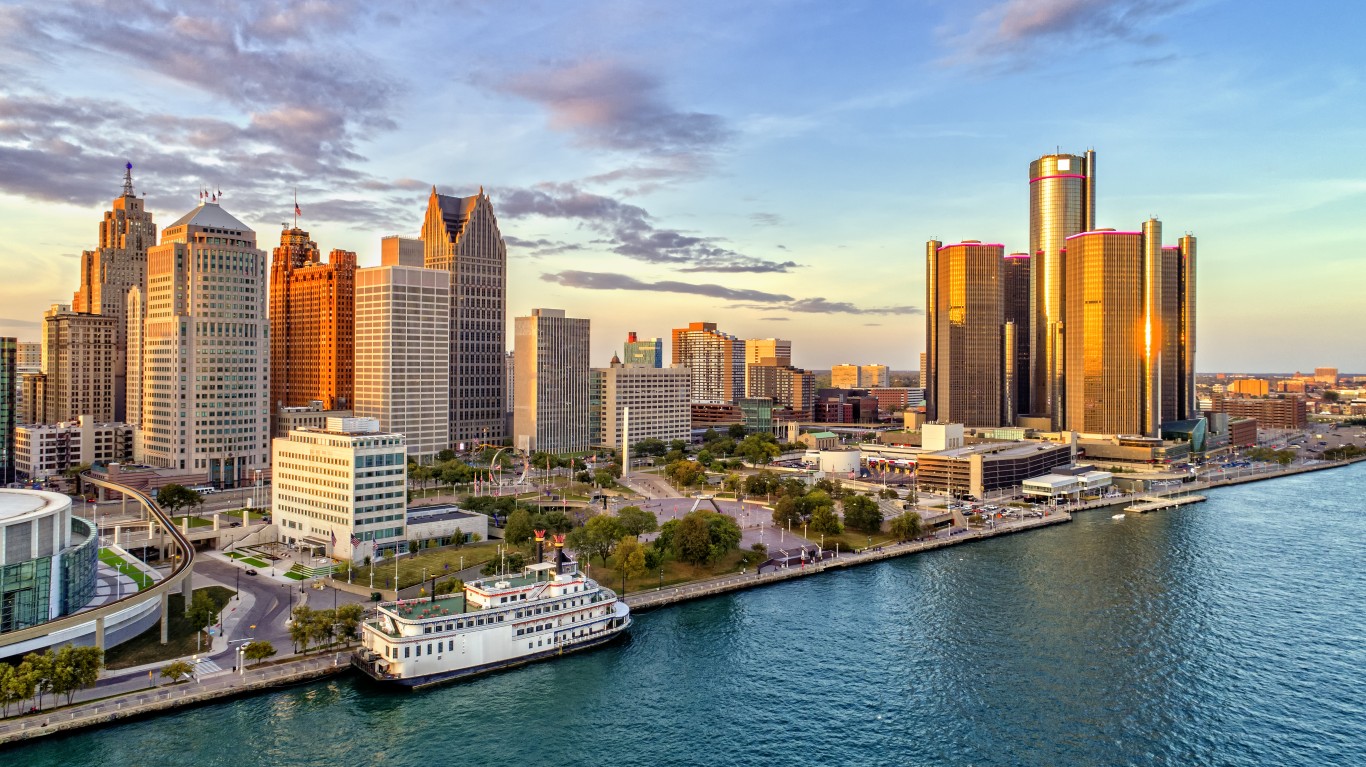
43. Michigan
> 1-year GDP change: -4.4%
> Fastest growing industry: Agriculture, forestry, fishing and hunting (+10.8%)
> Fastest shrinking industry: Arts, entertainment, and recreation (-43.9%)
> Nov. 2020 unemployment rate: 6.9%
Michigan reported a 5.6% contraction in manufacturing — its largest sector — between Q3 2019 and Q3 2020. The decline has had a devastating effect on the overall state economy, which over the same period contracted by 4.4%. The downward economic spiral has triggered an unemployment crisis in Michigan. The state has shed over 320,000 jobs in the last year, and the November 2020 jobless rate was 6.9% — well above the 3.9% jobless rate from one year earlier.
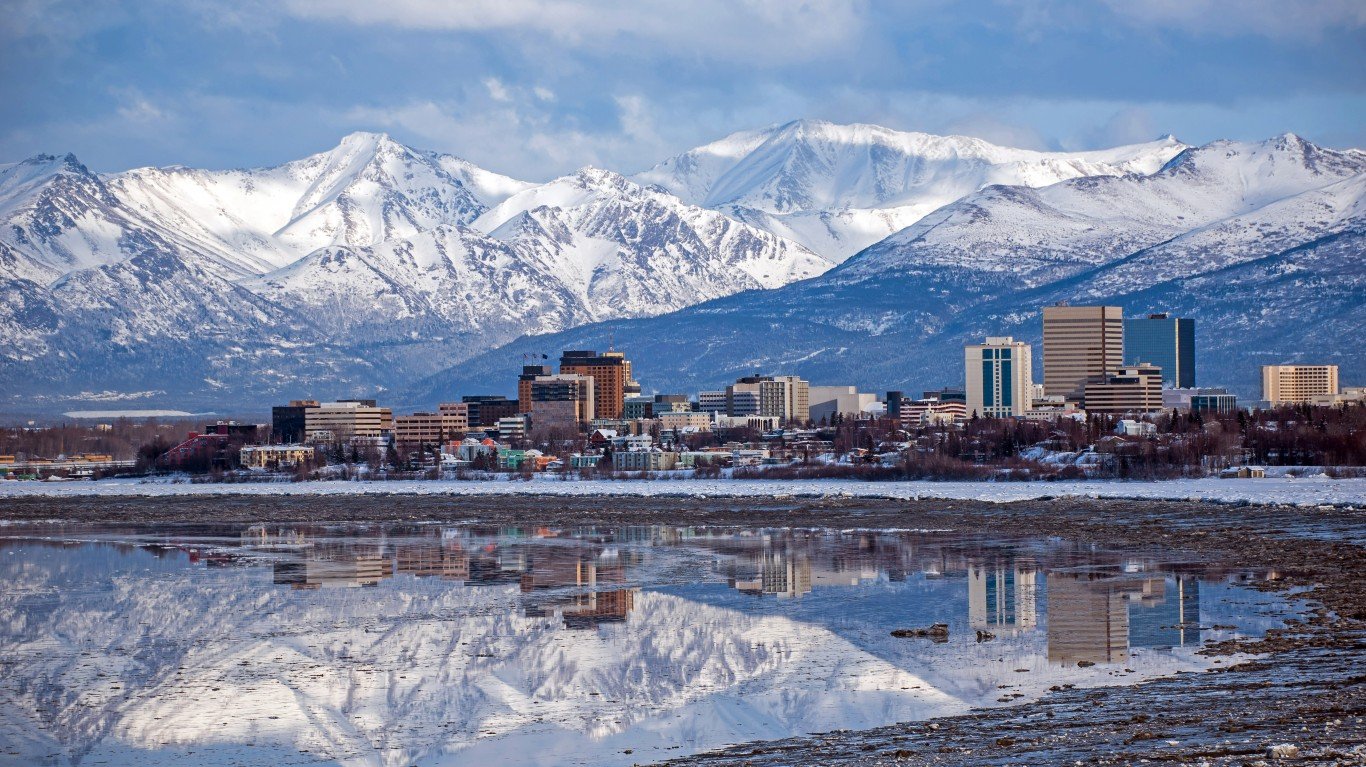
44. Alaska
> 1-year GDP change: -4.9%
> Fastest growing industry: Utilities (+11.0%)
> Fastest shrinking industry: Arts, entertainment, and recreation (-47.1%)
> Nov. 2020 unemployment rate: 8.1%
Mining, quarrying, and oil and gas extraction — an industry that was hit especially hard by the COVID-19 pandemic as demand for fuels plummeted during global lockdowns — is the largest industry in Alaska. Over the past year, the state’s resource extraction sector contracted by 9.1%. A handful of other industries, including arts, entertainment, and recreation, contracted by even more, all contributing to a near 5% decline in GDP between Q3 2019 and Q3 2020.
Unemployment is often relatively high in Alaska, and the pandemic has only added to pressures on the job market. As of November, 8.1% of the state’s labor force was out of work, well above the comparable 6.7% national jobless rate and the state’s unemployment rate one year ago of 6.1%.
[in-text-ad-2]

45. Louisiana
> 1-year GDP change: -5.0%
> Fastest growing industry: Utilities (+12.1%)
> Fastest shrinking industry: Arts, entertainment, and recreation (-32.4%)
> Nov. 2020 unemployment rate: 8.3%
Louisiana is one of six states in which the GDP in Q3 2020 was at least 5% lower than it was a year earlier. Amid the pandemic, many hospitals and other care providers suspended elective or nonemergency surgeries and procedures. While the nationwide health care GDP declined by 3.7%, no state health care sector shrank more than that of Louisiana, at 15.4%.
Louisiana’s total employment dropped by 3.1% from September 2019 to September 2020, one of the smaller decreases. Yet the state has still had one of the higher unemployment rates each month throughout the pandemic. Louisiana had the third highest unemployment rate of any state in February 2020, just before the pandemic hit, at 5.2%.

46. West Virginia
> 1-year GDP change: -5.0%
> Fastest growing industry: Utilities (+6.5%)
> Fastest shrinking industry: Accommodation and food services (-20.8%)
> Nov. 2020 unemployment rate: 6.2%
The number of employed people in West Virginia fell by 54,000, or roughly 7%, between September 2019 and September 2020. That percentage decline was the 14th largest of any state. Over that same period, the state’s GDP fell by 5%, the fifth largest decline of any state.
While the arts and entertainment sector was in most states the hardest hit by COVID-19, West Virginia is one of two states where the accommodation and food services sector registered the largest decline, with the sector’s output shrinking by 20.8%. The state is home to a substantial coal mining industry, and West Virginia’s mining, quarrying and natural resource extraction sector contracted by 17.4% through the third quarter of 2020.
[in-text-ad]

47. New York
> 1-year GDP change: -5.8%
> Fastest growing industry: Information (+7.3%)
> Fastest shrinking industry: Arts, entertainment, and recreation (-60.0%)
> Nov. 2020 unemployment rate: 8.4%
New York state was one of the first to be affected by the COVID-19 pandemic and one of the first to shut down large parts of its economy to combat the virus. In the 12 months ending in the third quarter of 2020, the state’s economy contracted by 5.8%, the fourth largest decline of any state.
The output of the arts, entertainment, and recreation industry, as might be expected given the restrictions on public gatherings that were in place for much of 2020, fell by a staggering 60% from the third quarter of 2019 through the third quarter of 2020, one of the largest contractions of any single state sector in the country.

48. Oklahoma
> 1-year GDP change: -6.3%
> Fastest growing industry: Management of companies and enterprises (+24.0%)
> Fastest shrinking industry: Mining, quarrying, and oil and gas extraction (-27.6%)
> Nov. 2020 unemployment rate: 5.9%
Oklahoma is one of three states in which the GDP dropped by over 6% from Q3 2019 to Q3 2020. In nearly every state, the arts sector was the fastest-shrinking industry during that time. Yet in Oklahoma, mining, quarrying, and oil and gas extraction was the fastest shrinking sector, contracting by more than 27%. This was the result of declining demand as travel slowed to a crawl and a price war between Russia and Saudi Arabia.
The mining, quarrying, and extraction industry in Oklahoma contributed $41.8 billion to the state’s overall GDP of $199 billion in Q3 2019. A year later, the sector contributed just $30.3 billion as the state’s GDP declined to $186 billion.
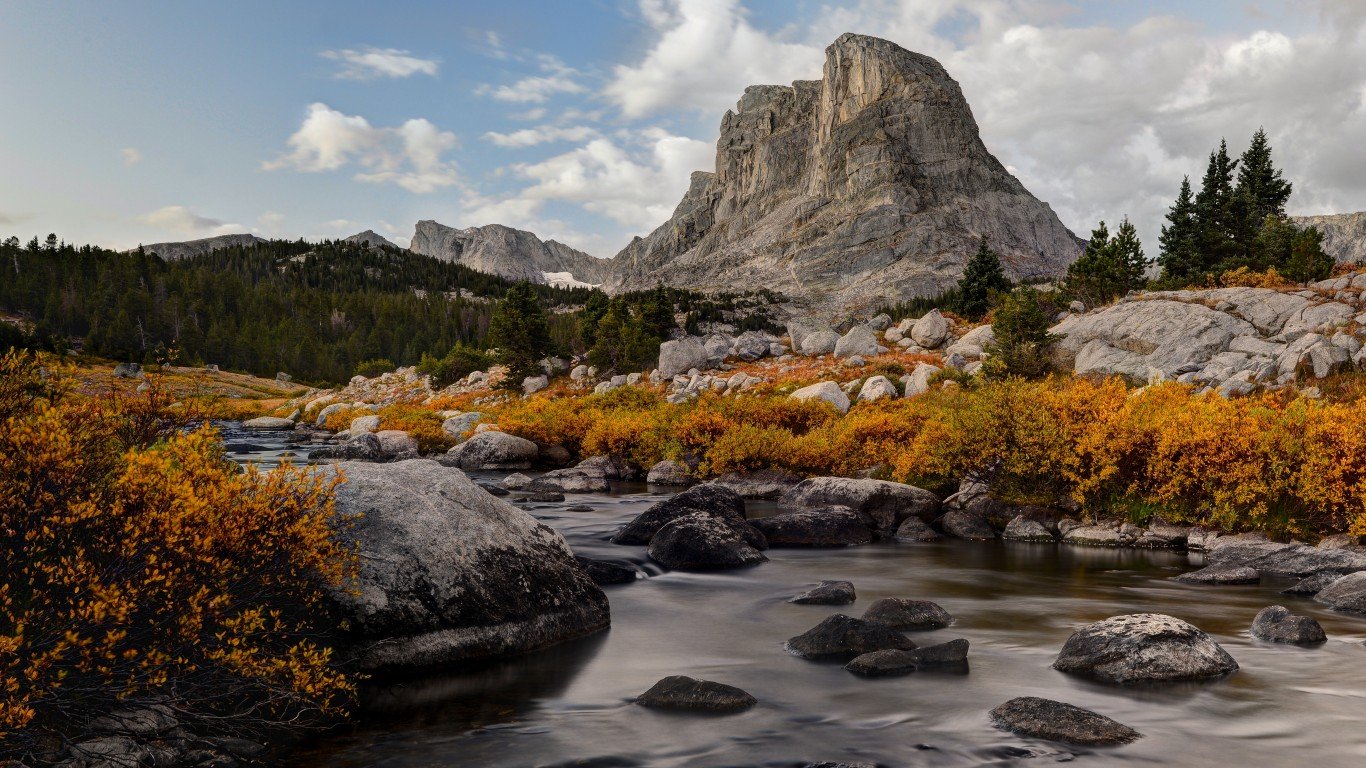
49. Wyoming
> 1-year GDP change: -7.9%
> Fastest growing industry: Utilities (+8.8%)
> Fastest shrinking industry: Agriculture, forestry, fishing and hunting (-28.5%)
> Nov. 2020 unemployment rate: 5.1%
Wyoming is the nation’s largest coal-producing state and one of the largest oil producers as well. The mining and natural resource extraction industry is the state’s largest employer. Between the third quarter of 2019 and the third quarter of 2020, the total output of that industry in the state fell by 23.9%, one of the largest declines for that sector of any state.
Despite that substantial drop, between September 2019 and September 2020, Wyoming’s total employment decreased by only about 5,500, or 2% — by both measures one of the smallest employment declines of any state over that time. Still, the state’s November unemployment rate of 3.7% was slightly higher than the comparable national unemployment rate of 3.5%.
[in-text-ad-2]

50. Hawaii
> 1-year GDP change: -8.2%
> Fastest growing industry: Utilities (+10.2%)
> Fastest shrinking industry: Arts, entertainment, and recreation (-50.9%)
> Nov. 2020 unemployment rate: 10.1%
No state has seen its economy slow down as severely as Hawaii amid the COVID-19 pandemic. Hawaii’s Q3 2020 GDP was 8.2% lower than it was in Q3 2019, falling from $82.4 billion to $75.7 billion. The state’s warm weather makes it a popular tourist destination, but with travel restrictions and reduced plane service, the state’s economic output due to tourism was cut in half. The accommodation and food service sector shrank by 43.7%, nearly double the 21.9% decline in that sector nationwide. Hawaii’s manufacturing and wholesale trade GDP both fell by over 10% from 2019 Q3 to 2020 Q3 — the largest declines of any state.
No state lost a larger share of its jobs than Hawaii. The Aloha State’s total employment dropped by 19.4% between 2020 Q3 and a year before. Its unemployment rate skyrocketed from the third lowest in March 2020, at 2.4%, to the third highest in April 2020, at 23.8%. As of November 2020, it still had the second highest unemployment rate.
Essential Tips for Investing: Sponsored
A financial advisor can help you understand the advantages and disadvantages of investment properties. Finding a qualified financial advisor doesn’t have to be hard. SmartAsset’s free tool matches you with up to three financial advisors who serve your area, and you can interview your advisor matches at no cost to decide which one is right for you. If you’re ready to find an advisor who can help you achieve your financial goals, get started now.
Investing in real estate can diversify your portfolio. But expanding your horizons may add additional costs. If you’re an investor looking to minimize expenses, consider checking out online brokerages. They often offer low investment fees, helping you maximize your profit.
Thank you for reading! Have some feedback for us?
Contact the 24/7 Wall St. editorial team.
 24/7 Wall St.
24/7 Wall St.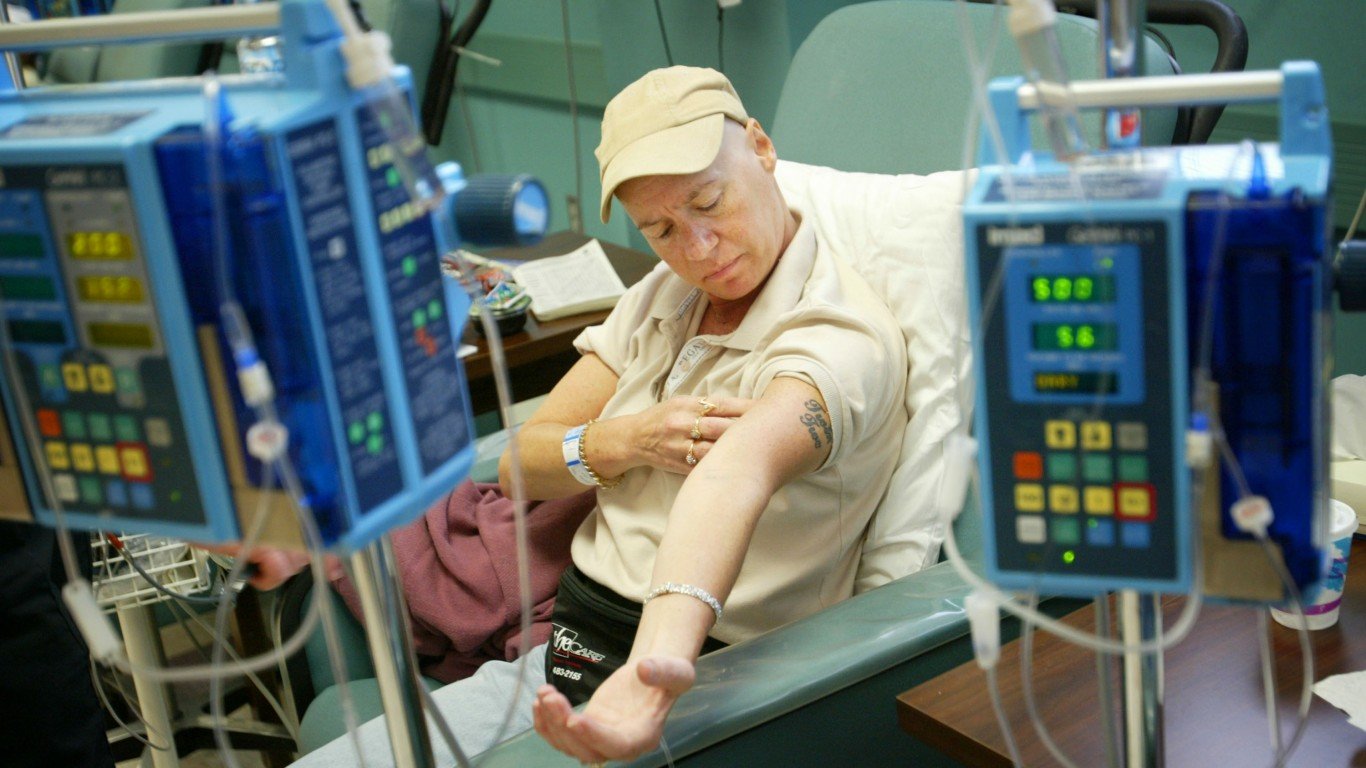 24/7 Wall St.
24/7 Wall St. 24/7 Wall St.
24/7 Wall St. 24/7 Wall St.
24/7 Wall St.